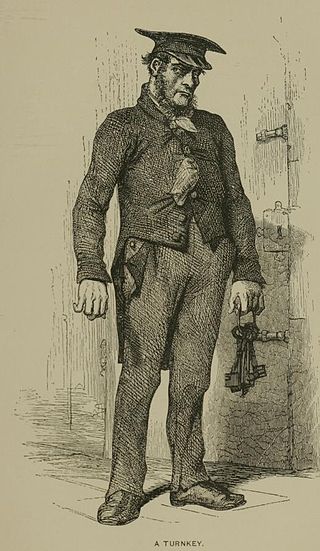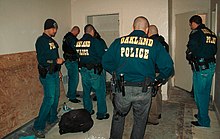
A detective is an investigator, usually a member of a law enforcement agency. They often collect information to solve crimes by talking to witnesses and informants, collecting physical evidence, or searching records in databases. This leads them to arrest criminals and enable them to be convicted in court. A detective may work for the police or privately.

The Maryland Department of Public Safety and Correctional Services (DPSCS) is a government agency of the State of Maryland that performs a number of functions, including the operation of state prisons. It has its headquarters in Towson, Maryland, an unincorporated community that is also the seat of Baltimore County, Maryland, United States, located north of Maryland's largest city of Baltimore. Additional offices for correctional institutions supervision are located on Reisterstown Road in northwest Baltimore.

The California Department of Corrections and Rehabilitation (CDCR) is the penal law enforcement agency of the government of California responsible for the operation of the California state prison and parole systems. Its headquarters are in Sacramento.
Criminal intelligence is information compiled, analyzed, and/or disseminated in an effort to anticipate, prevent, or monitor criminal activity.

A prison officer or corrections officer also known as a Correctional Law Enforcement Officer is a uniformed law enforcement official responsible for the custody, supervision, safety, and regulation of prisoners. They are responsible for the care, custody, and control of individuals who have been convicted of a crime and sentenced to imprisonment. They are also responsible for the security of the facility and its property as well as other law enforcement functions. Most prison officers or corrections officers are employed by the government of the jurisdiction in which they operate, although some are employed by private companies that provide prison services to the government.

In Brazil, the Federal Constitution establishes eight law enforcement institutions - seven titulars and one auxiliar. The titular institutions are: the Federal Police, the Federal Highway Police, the Federal Railroad Police, the Federal Penal Police, the State Military Police and Fire Brigade, the State Civil Police and the State Penal Police. Of these, the first four are affiliated to federal authorities and the latter three are subordinated to state governments. These public safety institutions are part of the Executive branch of either federal or state government. Apart from these eight institutions, there are others which affiliate to municipal authorities: the Municipal Guards. According to Minister Alexandre de Moraes of the Supreme Federal Court, "...the Municipal Guards are inserted in public safety as the auxiliary and related body of public security force..." Federal law 13,022 gave them de facto and de jure police attributions.
Protective custody (PC) is a type of imprisonment to protect a person from harm, either from outside sources or other prisoners. Many prison administrators believe the level of violence, or the underlying threat of violence within prisons, is a chief factor causing the need for PC units. Prisoners have the opportunity to request protective custody if they get the impression that the environment they are living in is harmful to their well being. Their request may be granted if the officials rule that the prisoner is truly at risk. Protective custody might simply involve putting the person in a secure prison, but usually protective custody involves some degree of solitary confinement. For people who are threatened because of their association with a certain group or gang, moving them to another section of the prison may be sufficient.

The Oklahoma State Bureau of Investigation (OSBI) is an independent state law enforcement agency of the government of Oklahoma. The OSBI assists the county sheriff offices and city police departments of the state, and is the primary investigative agency of the state government. OSBI works independent of the Oklahoma Department of Public Safety to investigate criminal law violations within the state at the request of statutory authorized requesters. The OSBI was created in 1925 during the term of Governor Martin E. Trapp.

The Hawaii Department of Public Safety is a department within the executive branch of the government of the U.S. state of Hawaii. It is headquartered in the 919 Ala Moana Boulevard building in Honolulu, Hawaii. The Department of Public Safety is made up of three divisions: Administration, Corrections, and Law Enforcement.
Law enforcement in Albania is the responsibility of several agencies. The responsibility for most tasks lies with the Albanian State Police, a national police agency, which is under the authority of Ministry of Internal Affairs. Examples of other agencies with limited policing powers are the Municipal Police, which has administrative functions and operates in the local level. They are controlled by mayors.

The Cook County Sheriff's Office is the principal law enforcement agency that serves Cook County, Illinois. It is the second largest sheriff's department in the United States, with over 6,900 members when at full operational strength. It is headed by the Cook County Sheriff, currently Thomas Dart.

The Department of Public Safety and Corrections (DPS&C) is a state law enforcement agency responsible for the incarceration of inmates and management of facilities at state prisons within the state of Louisiana. The agency is headquartered in Baton Rouge. The agency comprises two major areas: Public Safety Services and Corrections Services. The secretary, who is appointed by the governor of Louisiana, serves as the department's chief executive officer. The Corrections Services deputy secretary, undersecretary, and assistant secretaries for the Office of Adult Services and the Office of Youth Development report directly to the secretary. Headquarters administration consists of centralized divisions that support the management and operations of the adult and juvenile institutions, adult and juvenile probation and parole district offices, and all other services provided by the department.

The Alberta Sheriffs Branch is a provincial law enforcement agency overseen by the Ministry of Public Safety and Emergency Services of the province of Alberta, Canada. Under the authority of the Peace Officer Act, Alberta Sheriffs are provincial peace officers with jurisdiction over the province of Alberta. The premier of Alberta has the authority to grant emergency police powers to all Alberta sheriffs during major emergencies within the province. The Alberta Sheriffs Branch is the largest sheriff service in Canada.

The Florida Department of Law Enforcement (FDLE) is a state-wide investigative law enforcement agency within the state of Florida. The department formally coordinates eight boards, councils, and commissions. FDLE's duties, responsibilities, and procedures are mandated through Chapter 943, Florida Statutes, and Chapter 11, Florida Administrative Code. FDLE is headed by a commissioner who reports to the Florida Cabinet, which is composed of the governor, the attorney general, the chief financial officer, and the commissioner of agriculture. The commissioner is appointed to his position by the governor and cabinet and confirmed by the Florida Senate.

The California Department of Justice is a statewide investigative law enforcement agency and legal department of the California executive branch under the elected leadership of the California Attorney General (AG) which carries out complex criminal and civil investigations, prosecutions, and other legal services throughout the US state of California. The department is equivalent to the State Bureau of Investigation in other states.

The Los Angeles County Sheriff's Department (LASD), officially the County of Los Angeles Sheriff's Department, is a law enforcement agency serving Los Angeles County, California. LASD is the largest sheriff's department in the United States and the fourth largest local police agency in the United States, following the New York Police Department (NYPD), the Chicago Police Department (CPD) and the Los Angeles municipal Police Department (LAPD). LASD has approximately 18,000 employees, 9,915 sworn deputies and 9,244 unsworn members. It is sometimes confused with the unrelated Los Angeles Police Department which provides law enforcement service within the same county's county seat city.
The Pima County Sheriff's Department (PCSD) is an American law enforcement agency that serves the unincorporated areas of Pima County, Arizona. It serves the seventh largest county in the nation. It operates six district offices and three smaller satellite offices. The Corrections Bureau has four facilities which houses on average 1,850 inmates per day.

The New York City Police Department (NYPD) actively monitors public activity in New York City, New York, United States. Historically, surveillance has been used by the NYPD for a range of purposes, including against crime, counter-terrorism, and also for nefarious or controversial subjects such as monitoring political demonstrations, activities, and protests, and even entire ethnic and religious groups.

The New York City Police Department Intelligence Bureau is a division of the New York City Police Department (NYPD) which claims responsibility for the detection and disruption of criminal and terrorist activity through the use of intelligence-led policing. There is limited oversight over the Intelligence Bureau, and it conducts work in secrecy without the city council being informed of operations.

The Special Service Unit (SSU) is part of the California Department of Corrections and Rehabilitation (CDCR). The unit is staffed by special agents assigned to offices throughout the state. Although the special agents work for CDCR, they are neither correctional officers nor parole agents. SSU special agents are full-time peace officers per California Penal Code Section 830.2. This makes agents more akin to state police officers than to correctional officers.
















